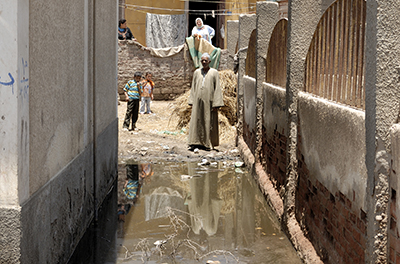Evaluating World Bank Performance in Egypt

One significant partner the Government of Egypt (GoE) has had in the development of Egypt`s built environment has been the World Bank, which has invested heavily in infrastructure projects such as electricity, waste water and natural gas, as well as in transportation and affordable housing. These investments come along with the Bank’s policy recommendations and technical assistance, which have included championing private sector involvement and phasing out government subsidies, while taking the stance that government should be an “enabler” rather than a “provider” of such services.
The Bank’s current portfolio (as of July 2012) of built environment-related projects is worth $3.18bn, roughly 81% of the total $3.945bn portfolio of active World Bank projects in Egypt. This long-term interest in Egypt puts the World Bank in a position to shoulder some of the responsibility for the state of the built environment in Egypt.
A study conducted by the Egyptian Initiative for Personal Rights [Arabic] (EIPR) seeks to explore the effectiveness of these investments in solving the challenges of the build environment in Egypt The Egypt 2006–2009 Country Assistance Strategy (CAS), extended until May 2012, sets out the main Bank objectives as facilitating private sector development, enhancing the provision of selected public goods and promoting equity.
Selected Findings
While the state seems to be the sole regulator of most of the elements that shape the built environment, in reality ownership is divided among the state, the informal private sector and the formal private sector. Besides the infrastructure services, such as energy, water and waste-water management, the other three components of the built environment (housing, transport and solid waste collection), are already for the most part “liberalized,” though this has not meant that they have performed any better than public sector services.
In order for a comprehensive built environment policy to be formulated, local community participation must be mainstreamed into both the policy development and project development frameworks, according to Bank policy. However, the study finds that “stakeholder participation” in the CAS was largely limited to central government and private sector affiliates, rather than including a broader range of affected stakeholders.
Half of the 14 built environment-related projects, totaling 63% of the built environment portfolio by investment value, triggered the Bank’s involuntary resettlement safeguard policy, indicating that the projects posed a risk displacing people from their lands, homes, or livelihoods as a direct or indirect result. Because involuntary resettlement has enormous impacts on families and communities, it is especially important that the Bank and the government weigh those costs with the stated public benefit of the project, and give serious consideration to alternatives, when resettlement or economic displacement are a possibility.
In 2009, the World Bank awarded Egypt a $300m loan to support housing programs. The Bank and the GoE reportedly agreed to allocate 40% of the sum to rehabilitated informal areas. However, the partners coincide in prioritizing the private sector as the beneficiary, dedicating over half of the $3.18bn earmarked for the World Bank’s built environment-related projects ($1.639bn) as “infrastructure services for private-sector development.”
In the view of the World Bank and GoE, one of the “distortions” that prevent the housing market from functioning efficiently is the Old Rent (i.e. rent control) Law and the small, underused mortgage sector. To address this, the World Bank proposed institutional frameworks and incentive structures to enable an expanded private-sector role in the financing and delivery of affordable housing. The increased revenues theoretically would help rationalize the subsidies provided to low-income groups, and ensure the continued development of a viable rental market.
Applying this methodology in practice seeks to transform the direct and indirect subsidies that go toward government-sponsored low-income housing projects into mortgage loans for the middle and low-income groups (75th–45th percentiles). These are to be funded through sustainable fiscal sources, mainly the private sector, freeing up the existing cash subsidy to be targeted at the lower-income groups in the form of rental and site-and-services projects, which but eventually would be phased out entirely.
However, the Mortgage Law No. 148 (2001) has been criticized for ignoring the fact that housing was already unaffordable. The house price-to-income ratio in Egypt is 7:1 and up, which is almost double that of most-developed nations (p. 16).
Mortgage financing has not been a popular option for Egyptian home buyers, as the costly and cumbersome property-registration process, restrictions on extending bank credit to the housing sector, lack of valuation information, lack of credit risk information, complex regulations and lack of sufficient legal infrastructure to enforce contracts have deterred borrowers. The Mortgage Law has achieved the increased commodification of the housing market in favor of private developer interests to supply expensive housing in an unregulated housing market. The result has been the market’s decreasing share of low-income housing and decreased affordability of formal housing for most needy Egyptians.
Taking an in-depth look at the 2006–2009 CAS has demonstrated several areas in which the World Bank in coordination with the GoE failed to address the true needs of Egypt’s citizens in the built environment. In the coming 18 months of the Bank’s new interim strategy, is the World Bank and GoE face a great opportunity—and challenge--to work with citizens and all stakeholders to develop a comprehensive plan for the built environment. This, in turn, will help to guide the Bank, GoE, and stakeholders in the development of a new, post-revolution CAS that will reflect the needs of the built environment and the Egyptian citizens who have kept it running for the past several decades.
The full draft EIPR report can be found here.
|